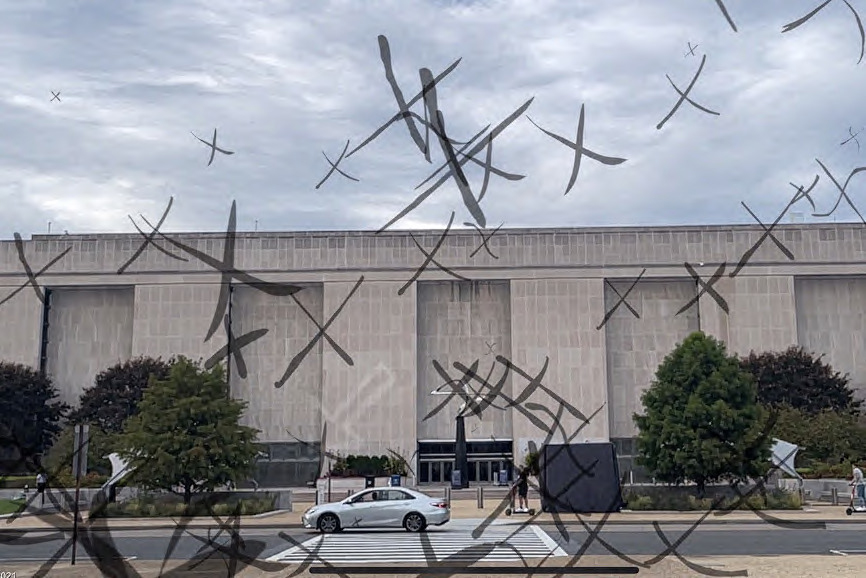Culture
 Artwork courtesy of the International Corporate Accountability Roundtable.
Artwork courtesy of the International Corporate Accountability Roundtable.
Social Justice Sightseeing: VR Art in the Capitol
January 6, 2022 @ 3:00pm
If 2021 was the year for revelations, 2022 is the year for accountability. That’s the feeling you get looking at any of the Capitol, Inc Project’s augmented reality art installations across the National Mall in downtown D.C., a sprawling collaboration between four artists and the International Corporate Accountability Roundtable (ICAR) that aims to expose the tight grip corporate power has on America.
ICAR’s position on corporate power is that it plays a partial to major role in every progressive issue in the U.S., despite being largely invisible throughout our everyday lives. The four separate virtual art installations they created were made possible by 4th Wall, a free, public augmented reality app that hosts and facilitates inclusive creative expression.
According to the installation project’s statement, art pieces from BIPOC artists focus on the harm caused by “unchecked corporate power and government malfeasance in big agribusiness, the oil and gas industry and the private prison system.”
That might feel like a mouthful, but what it essentially works to do is shed light on unchecked corporate power for the sake of accountability to the American public.
“We want to build a world where business activities are not built on labor and human rights abuses,” the ICAR website reads. “Where corporations are not emboldened to attack their critics, whether in the courts or on the streets; and where the government is responsive to the people and the public interest, instead of to corporate donors.”
Located at major hubs across the Mall, their message is hard to miss. “His X Mark” by Diné-Navajo artist, activist Emma Robbins, is a powerful commentary on Indigenous rights violations, set right in front of the Smithsonian Museum of American History. Opening the installation in the ICAR AR app displays a rolling screen of chicken-scratch X’s laid over the museum’s facade, seemingly endless in number and ever-populating. Each X represents an Indigenous leader’s signature on a U.S.-Native treaty that was later violated by the U.S.
Robbins uses her art to empower and raise awareness for Native communities, on every issue from clean water to missing and murdered Indigenous women. This piece is no less personal to her.
“If you don’t understand this, then you don’t understand American history, and you don’t understand why things are the way they are on so many levels, on any level of American history,” Robbins says.
The climate emergency and desecration of lands to fund big business and corporate interests is a hard-hitting point of these installations. Artist Stacey Lynn Waddell is responsible for an installation at one of D.C.’s most recognizable landmarks, the Reflecting Pool. In her piece’s title, Waddell pays homage to late afrofuturist writer Octavia E. Butler, who forewarned the disastrous impacts of global warming in her works “Parable of the Sower” and “Parable of the Talents.” Butler is oft-quoted for writing about rising tides, storms, and rampant heatwaves nearly two decades before now, and the installation — which features an emergency blanket over the Reflecting Pool — is named in honor of her and her afrofuturist pennings.
Alfredo Salazar-Caro champions ICAR’s exposé on corporate power and agriculture, primarily big agri-business. “Las Manos de Mis Padres,” according to Salazar-Caro’s artist statement, “draws on the agricultural history of the Latinx and Indigenous communities” while incorporating lived realities of migrant workers. The installation is a visual poem from a mastermind of digital art (Salazar-Caro is co-creator and creative director of DiMoDA, The Digital Museum of Digital Art, which is dedicated to virtual artworks). Digital cornstalks wave softly in front of the Department of Agriculture on Independence Avenue, a reference to corn as integral in Native life, but it also references one of the most climatically damaging crops the U.S. produces. Corn cultivation also happens to be a primary abusive industry for migrant workers. His piece critiques companies that prioritize profit over human rights, in a work environment that Salazar-Caro says “boils down to modern-day slavery.”
The final installation is a husband and wife team, Keith Calhoun and Chandra McCormick of New Orleans, Louisiana. For more than 25 years Calhoun and McCormick have been documenting Black religious and traditional cultures in Louisiana. Their VR piece is titled “Keith Calhoun, Angola Penitentiary, Who’s That Man On That Horse I Don’t Know His Name But They Call Him Boss, 1981,” is located facing the Department of Justice. The work depicts a former slave-breeding plantation, Angola, which is now a maximum-security state prison in Louisiana, and one of the many contributors to mass incarceration and the prison industrial complex.
It bears mentioning that these installations aren’t art for the sake of thinking about art; they are wholly activist art. The ICAR website offers a call to action in the description of each installation, including fact sheets, relevant data, and ways to get involved in solving the problem and holding corporate power accountable. There’s no subtlety there, no room for passivity. These are real problems, real people, and virtually real installations — right on your block.
To learn more about ICAR and the Capitol, Inc Project visit capitol-inc.org. Download the free ICAR AR app to experience these exhibits.
Enjoy this piece? Consider becoming a member for access to our premium digital content. Support local journalism and start your membership today.







